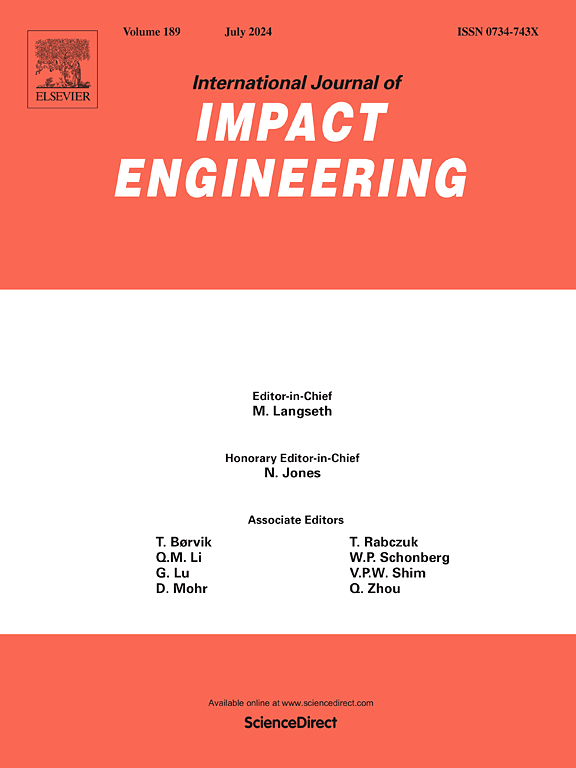Scaling global and local responses of RC structural members subjected to near-field blast loading
IF 5.1
2区 工程技术
Q1 ENGINEERING, MECHANICAL
International Journal of Impact Engineering
Pub Date : 2025-03-24
DOI:10.1016/j.ijimpeng.2025.105334
引用次数: 0
Abstract
Due to the strain-rate effect of materials, the test results obtained from scaled-down models might not be accurately extrapolated to those of the full-scale prototypes. In the present study, this challenge is addressed by modifying the scaled distance so that the model exhibits identical scalable behavior to the prototype. The global and local responses of reinforced concrete (RC) structural members subjected to near-field blast loading are major indices to evaluate damage extent, which are dominated by multi-governing factors, rather than a single factor, due to the complexity of the constituent materials. Consequently, the scaling laws of global and local responses may be inconsistent with each other. In view of this, the scaling methods of the global and local responses of RC members are proposed based on the Buckingham theorem, and are validated with the test results of RC members such as slabs and beams subjected to near-field blast loading. It is shown that the model developed applying the suggested scaling methods is able to precisely predict the global and local responses of prototype. Then, a scaling method considering the strain-rate effect and size effect is proposed. Furthermore, the distortion of reinforcement ratio frequently encountered in model tests, as well as the influence of constitutive equations on scaling results, are investigated. The proposed scaling methods in this study provide reference for the design and application of model test in the blast-related field.
将承受近场爆炸荷载的 RC 结构构件的整体和局部响应按比例放大
由于材料的应变率效应,按比例缩小模型得到的试验结果可能不能准确地外推到全尺寸原型的试验结果。在本研究中,通过修改缩放距离来解决这一挑战,使模型表现出与原型相同的可伸缩行为。钢筋混凝土结构构件在近场爆炸荷载作用下的整体和局部响应是评价结构损伤程度的主要指标,但由于构件材料的复杂性,结构损伤程度受多种因素而不是单一因素的影响。因此,全局和局部响应的标度规律可能不一致。基于Buckingham定理,提出了钢筋混凝土构件整体和局部响应的标度方法,并通过近场爆炸荷载作用下楼板、梁等钢筋混凝土构件的试验结果进行了验证。结果表明,采用所提出的标度方法建立的模型能够准确地预测原型的全局和局部响应。然后,提出了一种考虑应变率效应和尺寸效应的标度方法。研究了模型试验中常见的配筋率畸变以及本构方程对标度结果的影响。本文提出的标度方法可为爆破相关领域模型试验的设计和应用提供参考。
本文章由计算机程序翻译,如有差异,请以英文原文为准。
求助全文
约1分钟内获得全文
求助全文
来源期刊

International Journal of Impact Engineering
工程技术-工程:机械
CiteScore
8.70
自引率
13.70%
发文量
241
审稿时长
52 days
期刊介绍:
The International Journal of Impact Engineering, established in 1983 publishes original research findings related to the response of structures, components and materials subjected to impact, blast and high-rate loading. Areas relevant to the journal encompass the following general topics and those associated with them:
-Behaviour and failure of structures and materials under impact and blast loading
-Systems for protection and absorption of impact and blast loading
-Terminal ballistics
-Dynamic behaviour and failure of materials including plasticity and fracture
-Stress waves
-Structural crashworthiness
-High-rate mechanical and forming processes
-Impact, blast and high-rate loading/measurement techniques and their applications
 求助内容:
求助内容: 应助结果提醒方式:
应助结果提醒方式:


